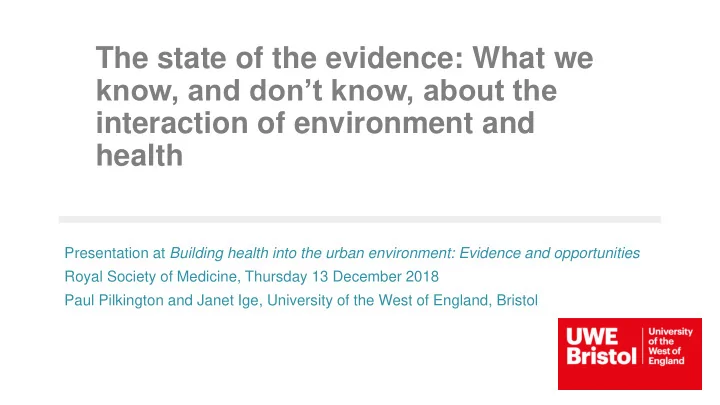

The state of the evidence: What we know, and don’t know, about the interaction of environment and health Presentation at Building health into the urban environment: Evidence and opportunities Royal Society of Medicine, Thursday 13 December 2018 Paul Pilkington and Janet Ige, University of the West of England, Bristol
UPSTREAM Project Team Prof Gabriel Scally , Principal Investigator PUBLIC ENGAGEMENT Prof Judy Orme , Principal Investigator Ruth Larbey , Project Manager Daniel Black , Project Director (Shape Our City) Science Communication Unit Dr Paul Pilkington , Research Lead Sophie Laggan , Project Coordinator (Literature Review and Interviews) (Shape Our City) Science Communication Unit Dr Alistair Hunt , Research Lead (Economics) Dr Margarida Sardo , Project Evaluator Eleanor Eaton , Research Associate (Shape Our City) Science Communication Unit Dr Laurence Carmichael , Project Faculty Eleanor Shipman , Participatory artist Lead (Something Good, Something Useful) Dr Ben Williams , Project Manager and Research Fellow INTERNATIONAL ADVISORS Janet Ige , Research Associate Prof Kristie Ebi , Advisor (Climate Change and Health) Dr Emily Prestwood , Research Associate Prof Roderick Lawrence , Advisor (Trans-disciplinarity) Prof Jim Longhurst, Senior Advisor
Presentation Outline • Context • Aim of review • Systematic review methods • Findings • Gaps and future challenges 3/30
Context 4
Moving health upstream in urban development planning 1 Estimating cost of poor quality urban environment 2 Exploring barriers and opportunities for creating healthy urban environments
Aim of review • To systematically review the health outcomes associated with urban developments and linked interventions: • Buildings • Neighbourhood Design • Transport • Food environment • Natural environment 6/30
Systematic Review Methods 7
8 HEALTH MAP Elements of urban form Multiplier Global Ecosystem Climate Stability Climate change Biodiversity Natural Environment Natural Habitats Natural Environment Air Water Land Built Environment Buildings Buildings Places Neighbourhood Design Streets Routes Activities Working Shopping Moving Transport Living Playing PHE Spatial Planning for Health tool Learning Local Economy Wealth creation Vancouver Healthy toolkit Resilient markets Community Social capital BREEAM Communities Social networks Lifestyle Diet/nutrition Food HUDU Rapid HIA Work-life balance Physical activity Egan Review
Quality Appraisal • Conducted using the Quality Six Quality Domains: Assessment Tool for Quantitative Studies 1. Selection bias 2. Design of the study • Studies were rated High, 3. Control of confounders Moderate or Low 4. Blinding 5. Reliability and validity of data collection 6. Reporting of dropout rate 9/30
Findings 10
Results • 26,428 studies retrieved from a range of electronic databases • Review of studies for suitability • Followed by quality appraisal • 209 studies remaining 11
Outcome Action areas Reduced risk of hypertension Improved mental health Improve walkability Reduced risk of prediabetes and diabetes Increased physical activity levels Access to facilities Improved mental health Reduced risk of obesity among women Enhance neighbourhood Neighbourhood connectivity Reduced limitation in performing ADL among design men Quality of evidence Improved mental health Improve access to open High quality Increased physical activity levels green space Moderate quality Reduced cardiovascular risk factors Low quality Reduced risk of non-accidental mortality Reduced risk of asthma Reduced risk of prediabetes and diabetes
Outcome Action areas Improve general health and respiratory outcomes Improve thermal quality Reduced blood pressure and ventilation Reduced cost associated with heating Improved school attendance among children Reduced mould contamination Reduced falls and fall related injuries among Improve quality of older adults housing Improved mental health Inadequate quality of Increased risk of mortality from coronary heat Buildings disease housing Quality of evidence Improved general health among previously homeless people Increase High quality Improved mental health among adults and access/relocation to Moderate quality children affordable homes or Low quality Improved educational achievement among young boys social housing
Outcome Action areas Increased physical activity levels Improve infrastructure Reduced risk of pedestrian motor vehicle collision for walking and cycling Reduced amount of car use Increased levels of walking and cycling Reduced risk of pedestrian motor vehicle collision Improve road safety Reduced risk of pedestrian injury Increased active transport Improve infrastructure for Transport public transport Reduced exposure to road traffic collision Quality of evidence High quality Increased risk of pre/post menopausal breast cancer Moderate quality Exposure to Low quality transportation noise Increased systolic blood pressure levels
Outcome Action areas Reduced BMI levels Increase access Reduced odds of obesity among girls supermarkets and Reduced odds of obesity among general population healthy food outlets Higher density of and Increased risk of diabetes proximity to fast-food Increased risk of obesity restaurants Increased childhood obesity and overweight Food Proximity of full-service Increased BMI levels restaurants Quality of evidence High quality Living far away from Reduced diet quality index among pregnant Moderate quality super- markets (≥4 miles) women Low quality Apple graphic designed by rawpixel.com / Freepik
Outcome Action areas Increased risk of cervical cancer Increased risk of brain cancer Exposure to Increased risk of dementia and Alzheimer’s environmental hazards disease Increased risk of Type II diabetes Increased risk of lung cancer Increased risk of myocardial infarction among males Poor academic performance among children Exposure to traffic noise Natural environment Increased risk of Type II diabetes Worsened mental health Reduced quality of life among women Quality of evidence Increased blood pressure High quality Reduce exposure to traffic Increased average life expectancy Moderate quality noise Result in high economic savings Low quality Improve access to open Improved respiratory outcomes green space Increased physical activity levels
Gaps and future challenges 17
Gap analysis: Neighbourhood design
Recommend
More recommend